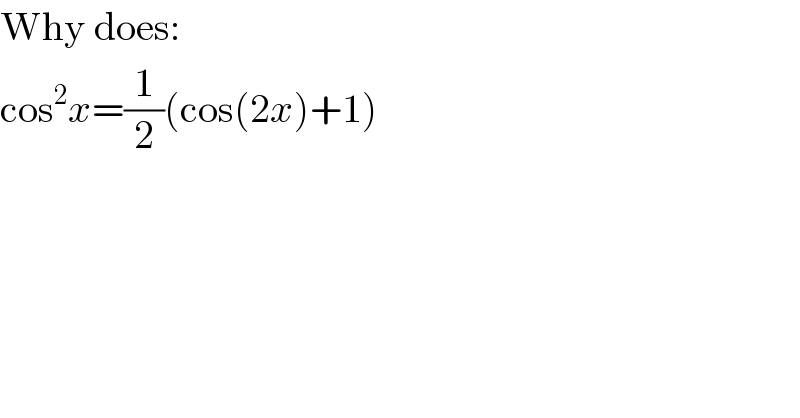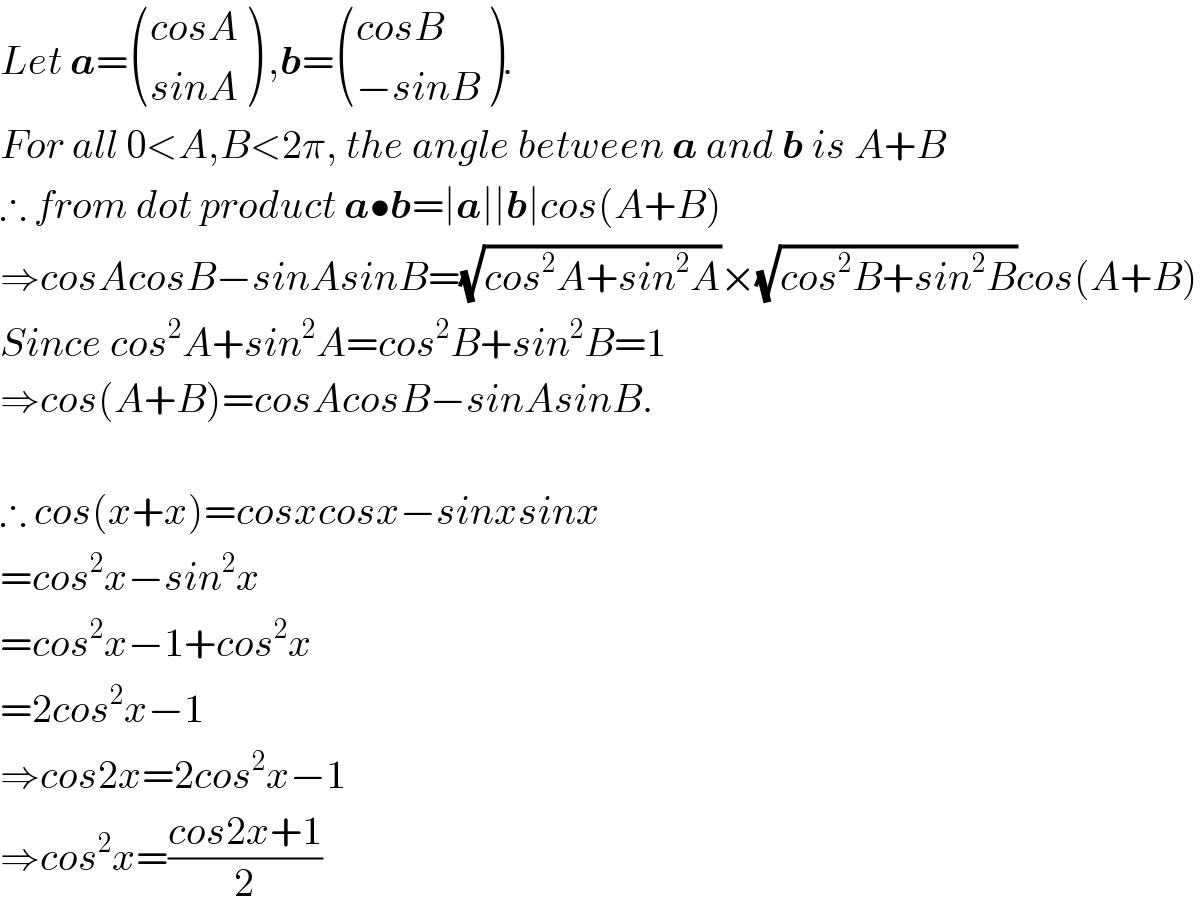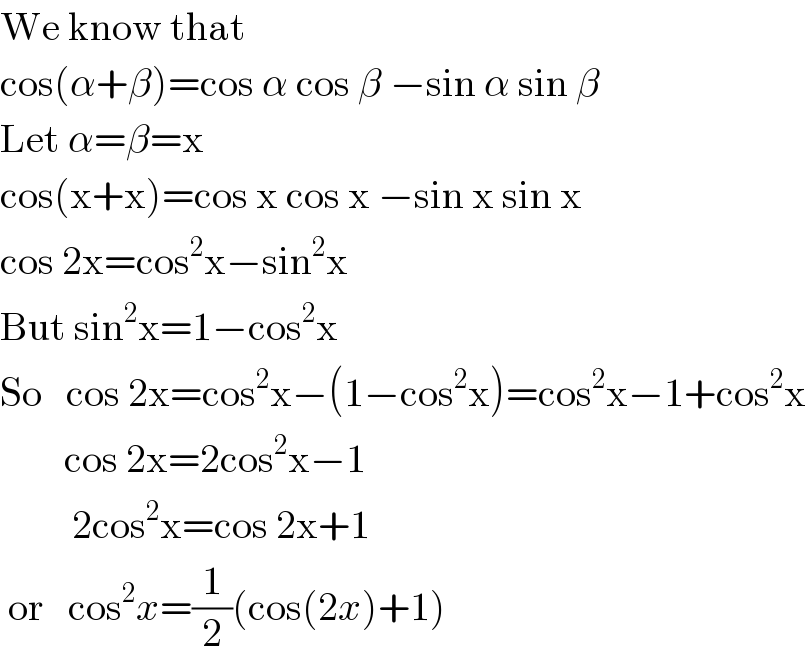
Question Number 5495 by FilupSmith last updated on 16/May/16

$$\mathrm{Why}\:\mathrm{does}: \\ $$$$\mathrm{cos}^{\mathrm{2}} {x}=\frac{\mathrm{1}}{\mathrm{2}}\left(\mathrm{cos}\left(\mathrm{2}{x}\right)+\mathrm{1}\right) \\ $$
Commented by Yozzii last updated on 16/May/16

$${Let}\:\boldsymbol{{a}}=\begin{pmatrix}{{cosA}}\\{{sinA}}\end{pmatrix}\:,\boldsymbol{{b}}=\begin{pmatrix}{{cosB}}\\{−{sinB}}\end{pmatrix}. \\ $$$${For}\:{all}\:\mathrm{0}<{A},{B}<\mathrm{2}\pi,\:{the}\:{angle}\:{between}\:\boldsymbol{{a}}\:{and}\:\boldsymbol{{b}}\:{is}\:{A}+{B} \\ $$$$\therefore\:{from}\:{dot}\:{product}\:\boldsymbol{{a}}\bullet\boldsymbol{{b}}=\mid\boldsymbol{{a}}\mid\mid\boldsymbol{{b}}\mid{cos}\left({A}+{B}\right) \\ $$$$\Rightarrow{cosAcosB}−{sinAsinB}=\sqrt{{cos}^{\mathrm{2}} {A}+{sin}^{\mathrm{2}} {A}}×\sqrt{{cos}^{\mathrm{2}} {B}+{sin}^{\mathrm{2}} {B}}{cos}\left({A}+{B}\right) \\ $$$${Since}\:{cos}^{\mathrm{2}} {A}+{sin}^{\mathrm{2}} {A}={cos}^{\mathrm{2}} {B}+{sin}^{\mathrm{2}} {B}=\mathrm{1} \\ $$$$\Rightarrow{cos}\left({A}+{B}\right)={cosAcosB}−{sinAsinB}. \\ $$$$ \\ $$$$\therefore\:{cos}\left({x}+{x}\right)={cosxcosx}−{sinxsinx} \\ $$$$={cos}^{\mathrm{2}} {x}−{sin}^{\mathrm{2}} {x} \\ $$$$={cos}^{\mathrm{2}} {x}−\mathrm{1}+{cos}^{\mathrm{2}} {x} \\ $$$$=\mathrm{2}{cos}^{\mathrm{2}} {x}−\mathrm{1} \\ $$$$\Rightarrow{cos}\mathrm{2}{x}=\mathrm{2}{cos}^{\mathrm{2}} {x}−\mathrm{1} \\ $$$$\Rightarrow{cos}^{\mathrm{2}} {x}=\frac{{cos}\mathrm{2}{x}+\mathrm{1}}{\mathrm{2}} \\ $$
Answered by Rasheed Soomro last updated on 16/May/16

$$\mathrm{We}\:\mathrm{know}\:\mathrm{that} \\ $$$$\mathrm{cos}\left(\alpha+\beta\right)=\mathrm{cos}\:\alpha\:\mathrm{cos}\:\beta\:−\mathrm{sin}\:\alpha\:\mathrm{sin}\:\beta \\ $$$$\mathrm{Let}\:\alpha=\beta=\mathrm{x} \\ $$$$\mathrm{cos}\left(\mathrm{x}+\mathrm{x}\right)=\mathrm{cos}\:\mathrm{x}\:\mathrm{cos}\:\mathrm{x}\:−\mathrm{sin}\:\mathrm{x}\:\mathrm{sin}\:\mathrm{x} \\ $$$$\mathrm{cos}\:\mathrm{2x}=\mathrm{cos}^{\mathrm{2}} \mathrm{x}−\mathrm{sin}^{\mathrm{2}} \mathrm{x} \\ $$$$\mathrm{But}\:\mathrm{sin}^{\mathrm{2}} \mathrm{x}=\mathrm{1}−\mathrm{cos}^{\mathrm{2}} \mathrm{x} \\ $$$$\mathrm{So}\:\:\:\mathrm{cos}\:\mathrm{2x}=\mathrm{cos}^{\mathrm{2}} \mathrm{x}−\left(\mathrm{1}−\mathrm{cos}^{\mathrm{2}} \mathrm{x}\right)=\mathrm{cos}^{\mathrm{2}} \mathrm{x}−\mathrm{1}+\mathrm{cos}^{\mathrm{2}} \mathrm{x} \\ $$$$\:\:\:\:\:\:\:\:\mathrm{cos}\:\mathrm{2x}=\mathrm{2cos}^{\mathrm{2}} \mathrm{x}−\mathrm{1} \\ $$$$\:\:\:\:\:\:\:\:\:\mathrm{2cos}^{\mathrm{2}} \mathrm{x}=\mathrm{cos}\:\mathrm{2x}+\mathrm{1} \\ $$$$\:\mathrm{or}\:\:\:\mathrm{cos}^{\mathrm{2}} {x}=\frac{\mathrm{1}}{\mathrm{2}}\left(\mathrm{cos}\left(\mathrm{2}{x}\right)+\mathrm{1}\right) \\ $$
